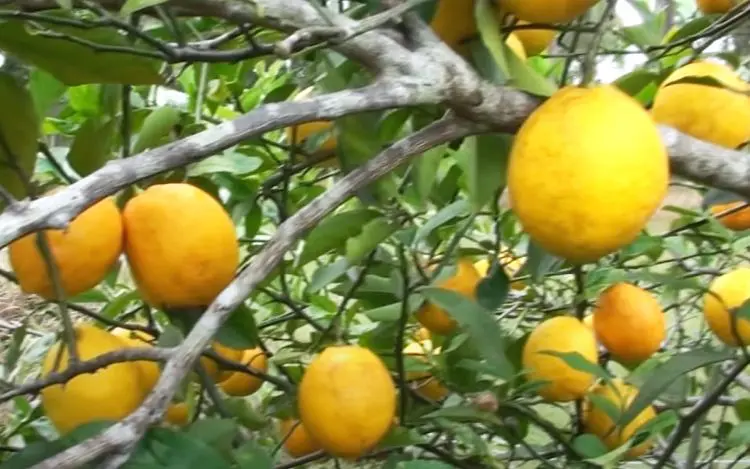There are literally thousands of fruit trees you can try to grow. So many, in fact, that it can be hard to narrow it down or know where to start. Whether you’re a beginner, short on space or just plain undecided, why not start with the easiest? Some fruit trees are so easy to grow that you’ll feel like you’re stealing the fruit- because you barely lifted a finger to produce it. Here are my top 5 fruit trees that are easiest to grow.
Lemons
Did you know that if it wasn’t for humans, lemons wouldn’t exist? Well it’s true- this fruit is man-made.

The original lemon was a cross between a citron (the original citrus fruit native to India) and a bitter orange. It was likely cross-bred over a thousand years ago, before making it’s way to Rome & establishing itself in Italian cuisine. Surprisingly, this cross even applies to wild or bush lemons. The one we grow here in Australia-which is thought to be a wild bush lemon-is a cross between a mandarin and a citron.
There are lots of lemon varieties to choose from. They’re all easy to grow, and they contribute an enormous amount to world food- I mean, where would we be without lemons?

Lemons are very hardy plants & will grow in most soils and climate types. Of all citrus, lemons tolerate cold the best. While they certainly thrive in warm and subtropical climates, there are varieties that can withstand negative temperatures. With some protection they may even be able to survive in temps as low as minus 10 C (14F).
You can of course grow a lemon tree in the ground, but they are great in containers too, and will still fruit profusely. If you’re short on space, even a sunny patio or balcony big enough for a large pot will suffice. That’s why there’s a saying that ‘every backyard should have a lemon tree’…because it’s so true !

Plum
Have you ever heard the saying ‘plum job’? The word plum used to be slang for soft or easy- hence the saying plum job, meaning an easy job that pays well. In the same vein, a plum is an easy tree to grow that pays you well in fruit.
Even a small plum tree can be worthwhile growing, due to its productivity & ability to fruit at a young age. It’s not uncommon for grafted plum trees to fruit within their first year.
Plums are not fussy when it comes to growing conditions, and can do well in most soils and climates. Plums are typically a cold climate plant which needs a winter chill with a cool temperature to trigger flowering and fruiting.
These days there are plums to suit all climates, including the subtropics. Warm-climate specific varieties have a low chill factor which allows them to fruit even through the mildest of winters, like ours here in south-east QLD.

Mulberry
There are many different varieties of mulberry tree you can grow, including hybrids which have been adapted to specific climates and soil types. The original silkworm mulberry was the white variety from central China. The black mulberry, (said to be the best for eating) is often called the English mulberry, despite being brought to the UK from western Asia in the early 1700s. The third well-known mulberry variety is the red mulberry which is native to the eastern USA.

In some areas, mulberries are considered an invasive plant; they are certainly a vigorous grower that can withstand adverse conditions. You can easily start a mulberry tree from a cutting. Simply cut off a section of a branch & pop it in a pot of damp soil at the start of the growing season. Cover the pot with a plastic bag and leave in a well-lit shaded position for several weeks. Roots should form within 8-12 weeks, and you’ll have yourself a brand new mulberry tree. This fruit tree grows fast and will set fruit early in its life. Mulberries are said to fruit much better in the ground than in a pot.

Mulberries are fantastic eating but have a very short shelf life. For this reason they are best eaten fresh, made into jam or stewed up into a pie.
Kumquats
Kumquats are a type of citrus that look like mini oranges. But don’t be fooled- they are a completely different fruit. Kumquats have a unique blend of sweet and sour flavours when eaten whole, because the skin is sweet & the flesh is sour. The sourness often scares people away but it shouldn’t; it’s all in how you eat them. Kumquats can be candied, dried, and frozen for adding to drinks. You can make them into jams, chutneys and marmalade too- they are such a versatile fruit!

Kumquats originated in south-east Asia and were first brought to Europe in the 1800s. They were found to be hardy trees that could be grown in a range of climates, and soon adapted to new habitats there.

Kumquats are on my list of top 5 fruit trees to grow because of their versatility, hardiness and high fruit production. These trees grow in all types of soil and can handle both very hot (up to 38C) and very cold (-10C) weather. They produce a lot of fruit and here in the subtropics they fruit almost year-round.
All kumquats do well in pots, regardless of the variety and/or climate. In China they are considered a good luck plant and are used by bonsai growers. The round kumquat is best for cold climates and the oval-shaped ones prefer the heat.
Apples
Apples have been cultivated by humans for a really long time; Alexander the Great is credited with having found dwarf apples in Khazakstan some 2500 years ago. So it should be no surprise that these days we have over 7500 varieties to choose from. This means that no matter where you live, there will be an apple that suits your climate and location.

Apple trees are typically grown in cooler regions, but these days you can get apple varieties that will grow in just about any climate. ‘Tropical Anna’, for example, is a low chill red variety that grows well in the poorer soils & humidity of subtropical south-east QLD. Container growing suits apple trees as they can be pruned and trained to fit where ever you need them to go.
Apple trees grow easily and fast from seed. I’ve even had apples self-seed in our garden from fallen fruit. In fact, all the trees I’ve discussed here can be grown from seed. However, be aware that the fruit you get from seed-grown fruit trees may be not be the same as that from the parent plant. Sadly it is often worse. You can propagate your favourite fruit trees by grafting a branch section onto a rootstock, which will create a clone of the parent tree.
And that’s my top 5 easiest fruit trees to grow! Why not try one yourself, and let us know how you go!













